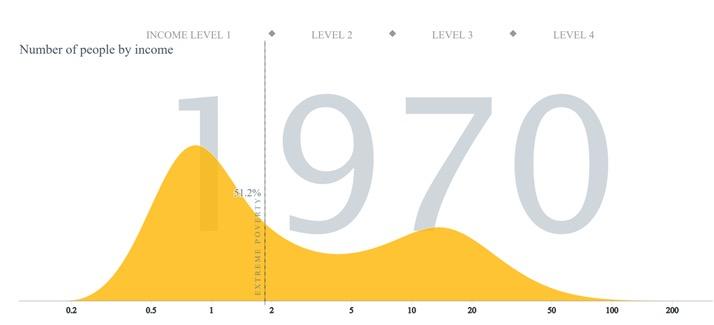
17 minute read
2. Rupture and obsolescence atthebeginning ofthe 21st century
2. Rupture and obsolescence at the beginning of the 21st century
Roughly concentrated in the first decade of the 21st century, several upheavals of very different kinds have contributed to profound changes in ODA’s ecosystem and have led to controversy over the very foundations of global ODA policy.
2.1 – The emergence and end of a world in two blocs
In the 2000s, a new category of countries began to play a major role in international relations and the world economy. These are most often referred to as emerging countries. Some of them are economic and demographic giants, like China and India.
This emergence represented a world upheaval that took place mainly in the first decade of the 21st century. In 2000, OECD countries still accounted for 81% of world GDP: the same proportion as in 1970. In 2020, this share of world GDP was 62%16, about 20% lower (68% in 2010).
This economic shift, however, has had little impact on the division of the world between “donors” and “recipients” of aid, as shown in box 1 above on developments in DAC lists. All emerging countries are still eligible for and are receiving aid, including China for a few more years, and Mexico. At the same time, these countries have become major global players, and in particular providers of international official transfers for development purposes, but according to specific norms, which are neither declared nor recognized as ODA.17
The rise of the large emerging countries has overcome the separation of the world into two blocs as shown in the graph below, which shows the distribution of income among the world’s population in 1970 and 2019.
The comparison of the two breakdowns is striking. It shows the disappearance of a world divided between North and South. The population to the left of the vertical poverty line remains large and geographically concentrated, but the curve is globally Gaussian, showing the emergence of a global middle class.
The term “Third World” is now obsolete. Yet development aid is still largely based on this concept, as well as climate negotiations which the groups of countries have essentially taken up. OECD countries are still frequently referred to as industrialized countries, even though the majority of manufacturing production is now carried out in the South and the industrial share of GDP is globally higher in the South than in the North.
Figure 4 – Breakdown of the world population by income level in 1970 and 2019
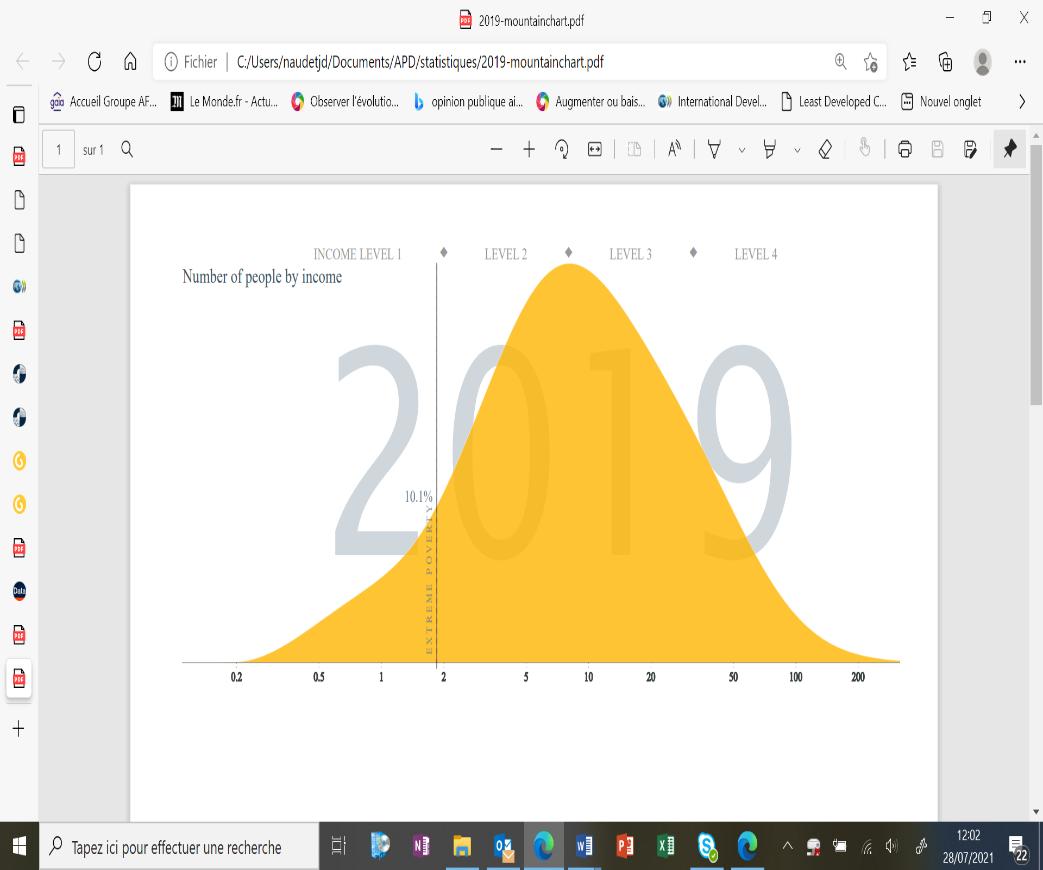
Source: Gapminder. Income Mountains | Gapminder
16 Meanwhile, the OECD has expanded to include several newcomers since the beginning of the 21st century, and now includes Chile,
Colombia, Costa Rica, Estonia, Israel, Latvia, Lithuania and Slovenia. 17 Turkey does make statements to the DAC about its development work, but this is not counted as official ODA.
Table 1 - Distribution of ODA by recipient country categories in 2019
Source: WDI Low income countries
Lower middle income countries
Higher middle income countries
The division of the world into two blocs also contributes to a phenomenon of thinly-spread ODA, particularly in large emerging countries and more generally in middle-income countries.
As can be seen, ODA allocated to middle income countries is as much as ODA to low income countries,18 while it is only 0.6% and 0.06% of GDP on average for lower and higher middle income countries respectively. The low percentages are largely due to the presence of India and China in each of these categories, but they nevertheless reflect a real phenomenon of thinly-spread aid in middle-income countries where the relative level of aid is often very low.19 However, inequality between countries remains very high. The GDP per capita of the 10 richest countries in 2020 is almost 200 times higher than in the 10 poorest countries: a gap that is much larger than in 1970, even though it has begun to narrow since 2005 (see figure 5 below).
So what is at issue is not the principle of a public transfer between the richest and poorest countries, but the fact that it is based on a binary distinction between developed and developing countries.
Figure 5 – GDP per capita ratio between the 10 richest and 10 poorest countries
TOTAL ODA
34%
26%
8% ODA PER CAPITA (CURRENT $)
70
14
5 ODA/GDP
10%
0.6%
0.06%
350 300 250 200 150 100 50 0
Source: WDI
18 A significant portion of ODA is not attributable to a particular geographical location, which explains why the total percentages of ODA allocated to different groups of countries by income level is less than 100%. 19 In 2019, 42 ODA recipient countries received less than 1% of their GDP in aid.
2.2 – New international threats: ODA in situations of“fragility”
“Not least since 11 September 2001, a group of countries has quickly moved from the periphery of the international community to the top of the policy agenda. It is an extremely heterogeneous group of 30-50 countries, which are loosely characterized by weak institutions and poor governance, often in combination with violent conflict” (Von Engelhardt 2018).
After a decade of decline following the fall of the Berlin Wall, ODA rose again in 2001, showing how aid mobilization is linked to the existence of international threats to donor countries.
Globalization challenges, such as violent conflicts, increasing migration and numbers of refugees, as well as climate change as a global challenge, have turned discourses on development cooperation away from development-oriented motives towards the strategic interests of development cooperation providers, such as expanding their own political and economic opportunities (Chatuverdi 2021).
In 2001, the World Bank launched a working group based on a new concept: LICUS (Low Income Countries Under Stress). Since then, the term fragility has come to be used to describe situations marked by various forms of insecurity, which raise particular questions from the international community’s point of view. In 2009, Robert Zoellick, President of the World Bank, stated that “fragile states are the greatest challenge to development of our time”, and the World Bank subsequently devoted its 2011 Development Report to the theme of conflict, security and development (World Bank 2011).
This change in context has marked the return of geopolitics to the heart of development aid issues. The terrorist threat, which is still present, had a decisive impact on the mobilization and allocation of ODA during the first two decades of the 21st century. A return to a new Cold War may be the new threat that will guide some of the future aid flows; this is already underway, following Russia’s attack on Ukraine. Figure 6 – Main ODA recipients in the 21st Century
90 80 70 60 50 40 30 20 10 0
Iraq Afghanistan Ethiopia Syrian Arab Republic
Cumul 2000-2019. Milliards $
Nigeria
Source: DAC/OECD
The list of the largest recipients of ODA since the beginning of the century speaks volumes about the role played in aid by geopolitical and security issues during the 21st century. In 2000, 15% of ODA was allocated to conflict-affected countries or in fragile situations. This soared to 30% in 2010 and 36% in 2019 (WDI).
ODA to fragile and insecure countries exacerbates the different motivations for aid and of course amplifies the tension between them. Firstly, the threats are the greatest there and the interests to be defended are thus proportional; secondly it is also in these countries that human distress is the most severe, and humanistic duties the most urgent.
Beyond conflict-affected countries, the focus on the most troubled countries on the international agenda has brought two major criticisms of “traditional” ODA back into the debate.
On the one hand, the criticism of domination: in the context of fragile states and under the effect of decolonial approach, but also more broadly the emergence of questions of recognition and dignity in the social sphere (Rosanvallon 2021), the dual nature of power/duty of ODA as analyzed by Murray Li (2007) has been criticized: “the will to take action for others has two sides: to improve their lot – i.e. the exercise of an altruistic will –, and at the same time, to regulate their conduct and keep them under supervision – i.e. the exercise of a will for power.”
Figure 7 – Number of people in extreme poverty in fragile states
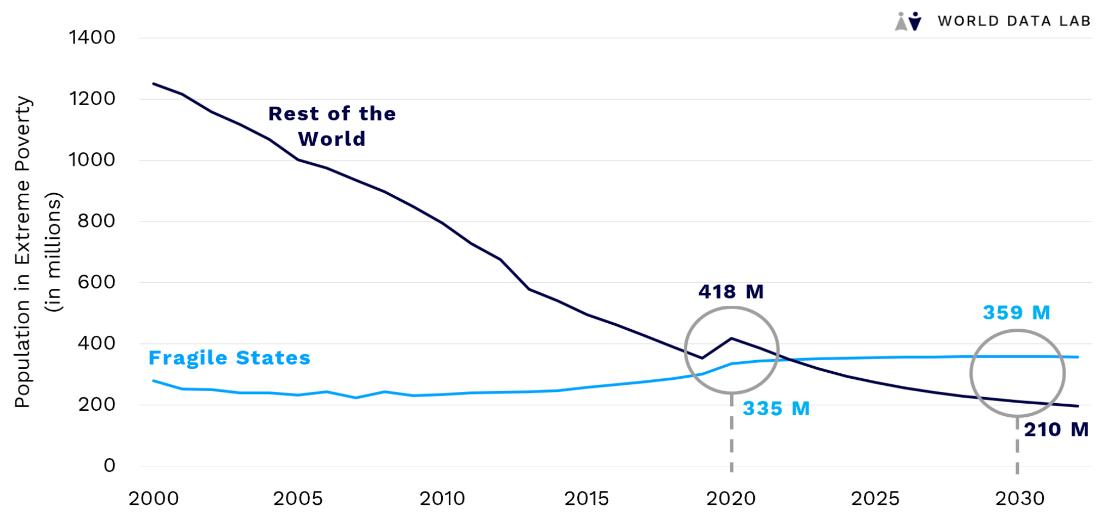
Source: World Data Lab
On the other hand, and even more centrally, the criticism of effectiveness. As seen above, the effectiveness of aid in fragile states, where institutions are weak and aid is considerable, is particularly questionable. The graph below illustrates this point empirically.
The combat against extreme poverty will increasingly be fought in fragile countries. By 2030, more than 80% of people in poverty will live in fragile states (OECD 2018).
It is true that ODA is only marginally responsible for failures in the fight against poverty in fragile countries. They primarily involve a variety of factors, including political factors, wars and environmental issues. However, the graph seems to show that there is probably little hope for a continuation of “business as usual” aid in the future.
Going back to the principles, the case of fragile states and new international threats raises the question of international action in situations where interests are not aligned between ODA stakeholders: populations and civil societies in the North, governments in the North, governments in the South, populations and civil societies in the South.
This alignment is a kind of unstated presupposition of ODA, as the Paris Declaration on Aid Effectiveness (OECD 2005) made clear by making it a principle. It is the alignment of interests that effectively enables the effectiveness, in terms of development, of state-to-state cooperation, and eliminates the question of domination/interference when cooperation directly affects populations and civil societies.
This unconsidered aspect challenges ODA as regards the heart of its mission: the fight against poverty in the most disadvantaged countries.
2.3 – The dilution of ODA in the face of sustainable development objectives: “from billions to trillions”
At the same time as ODA was focused on the group of poor and fragile countries, and contested, it was diluted as regards the broader issue of financing for development. Over the long term, with financial globalization, ODA has in fact gradually occupied an ever-smaller place in international capital flows to developing countries. It now accounts for only about 5% of capital flows to developing countries (figure 8): less than one-third of migrant remittances.
Figure 8 – International capital flows to developing countries
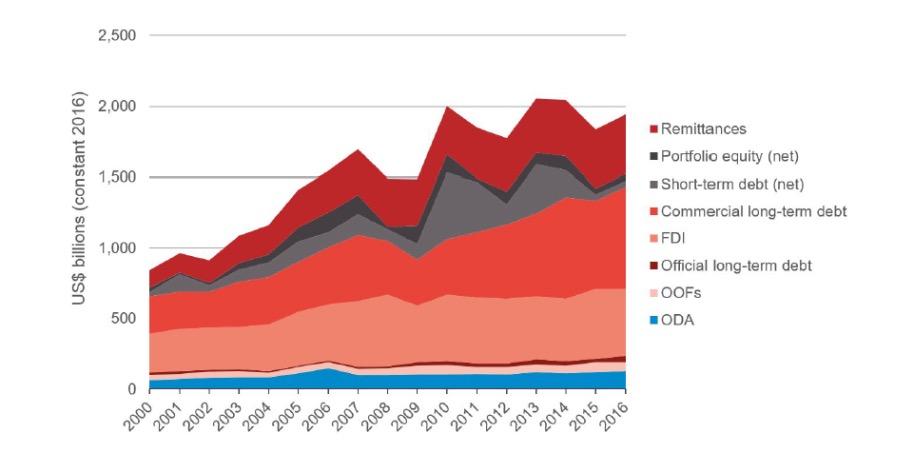
Source: Understanding ODA in the mix of all international resources - Development Initiatives (devinit.org)
As long as ODA was aimed at relatively narrow objectives, such as poverty reduction or universal primary education, and generated a need for targeted international public investment flows in addition to local resources, it warranted a specific place among all international capital flows.
The adoption of the SDGs in 2015 has changed the context in which ODA operates. The SDGs are common goals for all developed and developing countries. They no longer define a specific challenge to the South for the international community, as MDGs did. This is clearly illustrated by the fight against global inequality, as shown in the graph below.
The rupture in the trend in 1980 is spectacular. In the second part of the 20th century, the fight against global inequality was primarily a fight against inequality between nations, which represented 57% of total inequality in 1980. In the 21st century, the situation is clearly different. In 2020, nearly 70% of global inequality is intra-country, and the slope of the curve suggests that this proportion will increase. In other words, North-South ODA transfers appeared to be a perfectly appropriate tool to fight global inequalities in the 20th century, but today they are only a secondary or indirect instrument: the main action is played out at the level of national trajectories.
Like MDG 10 on reducing inequality, other MDGs are “transitional” or political goals that are not primarily associated with an investment gap, which should be filled by additional resources, such as MDG 12 on sustainable production and consumption. Other MDGs, such as MDG 9 on infrastructure and industrialization, rely heavily on the mobilization of private capital. Counting only the public capital spent on it makes little sense. Finally, global public goods – climate (SDG 13), and biodiversity (SDG 15) – are still quite separate goals, which will be discussed in the next section.
Figure 9 – Global income inequality: inter- and intra-country inequality (Theil index)
Source: World Inequality Report 2022
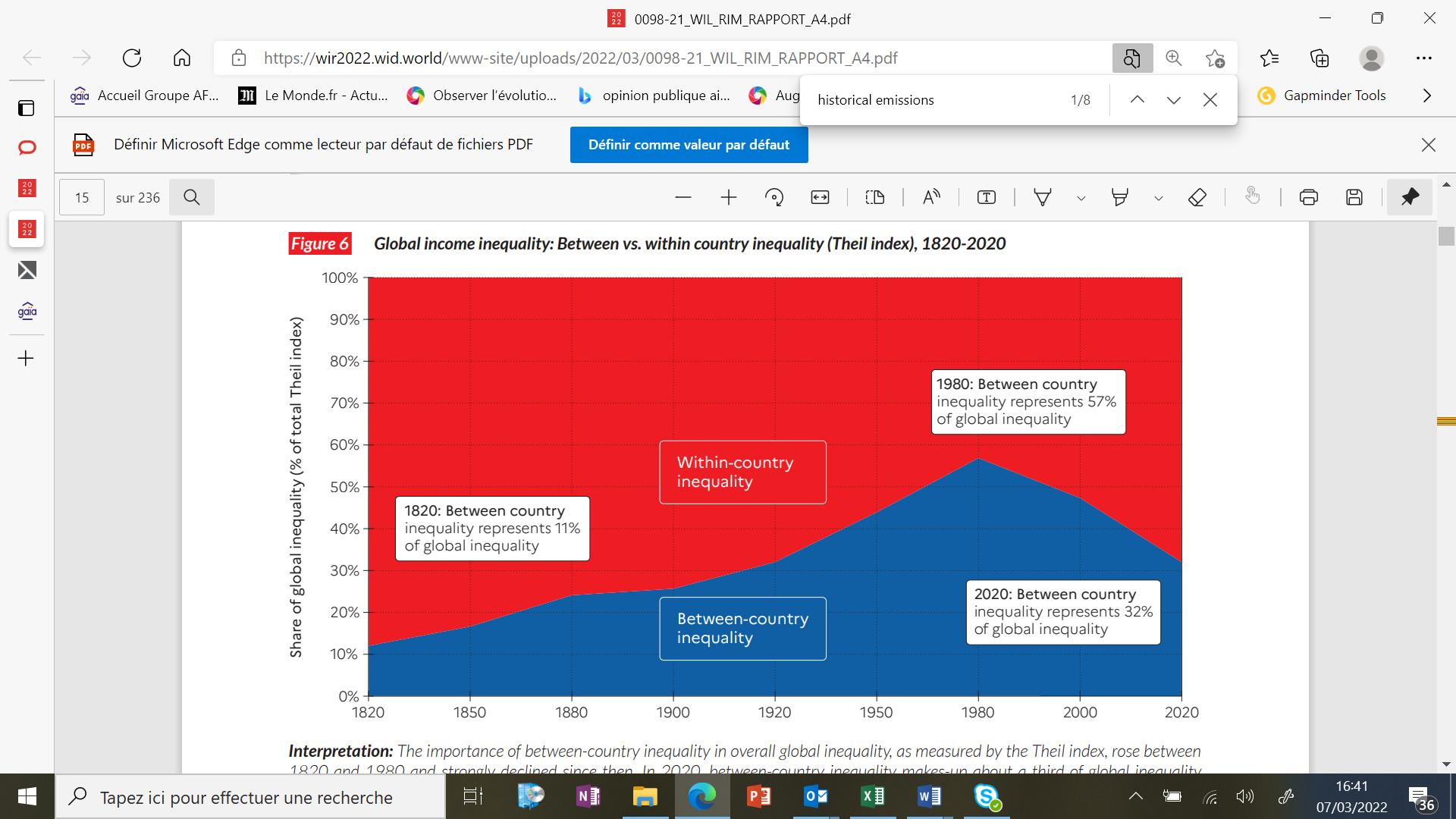
The result is a twofold challenge to ODA. Firstly, the shift from MDGs to SDGs completely changes the scale of the capital at stake, which the World Bank has translated into the widely used slogan (Mawdsley 2016) “from billions to trillions.” The amounts of ODA no longer seem able to make a difference with this objective for achieving SDGs. Kharas and McArthur (2019) estimate total annual global public flows in sectors directly related to SDGs at $21 trillion, in which ODA accounts for only 0.8%. Estimates for additional annual capital requirements to achieve SDGs in developing countries are around $1 trillion to $1.5 trillion annually, or 7 to 10 times the current ODA (Schmidt-Traub 2015; Kharas and McArthur 2019).
Secondly, the separability of ODA from other capital flows has lost some of its consistency. The broadening of the goals raises multiple questions about the boundaries and nature of ODA: boundaries, because the separation between local and international flows, public and private flows, and concessional and market flows is being called into question; and nature, because the challenge for some of the MDGs is as much about redirecting existing capital as providing additional capital. Achieving the SDGs will require a change in the development trajectory and a reorientation of certain activities and investments, particularly those that lead to the unsustainable consumption of resources: annual public and private financing for fossil fuels represents over 5,000 billion, for example (Gemenne 2021).
ODA now appears to be only a small part of international financing for sustainable development, whose effects are difficult to separate from those of other types of flows. Its character as a specific global public policy is to an extent dissolved within broader international issues like climate, transitions, inequalities, the fight against pandemics and the protection of biodiversity.
However, this phenomenon of the overall dilution of ODA needs to be qualified in two ways. Firstly, despite their small amount, ODA flows have a particular “quality” (in terms of stability, guarantee and as a signal), resulting in particular from the experience of global and global South issues, that leads the rest of the financial system to accord them a value more than proportional to their amount. Secondly, ODA flows are not marginal in the case of the poorest countries, for which other types of capital inflows are still modest.
Figure 10 – Gross disbursements from DAC countries to developing countries in 2018-2019
Source: OECD Overview: External Financing to LDCs (oecd.org)
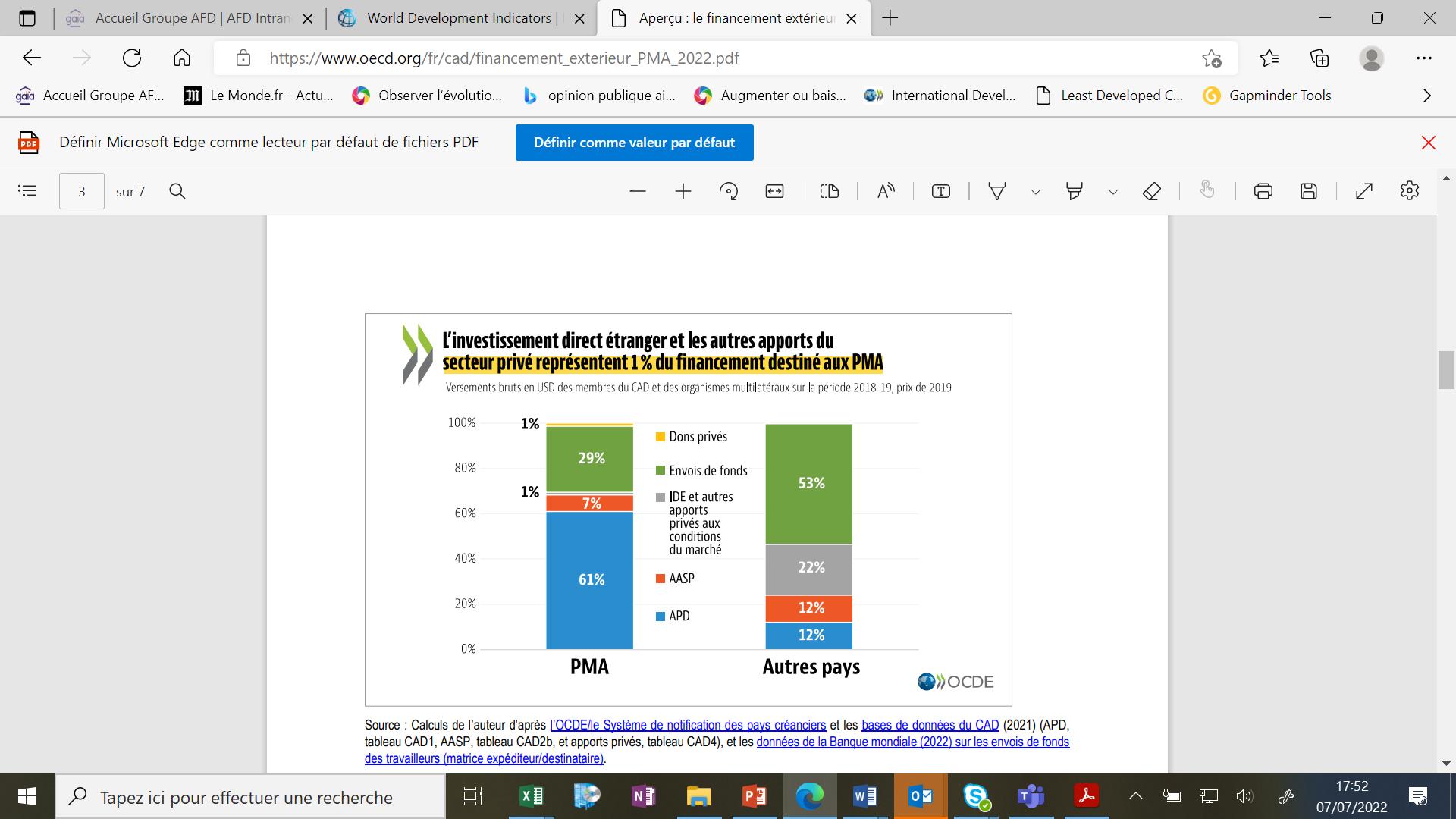
As indicated in the previous point, the case of poor and fragile countries needs to be considered in its own right.
2.4 – The climate question: reciprocity tested by responsibility and interdependence
The first decade of the 2000s was finally the decade of widespread awareness of climate issues with the third IPCC report in 2001 – often presented as the scientific consensus on the anthropogenic origin of climate change –, the Earth Summit in 2002 and the Stern Review in 2006. More globally, this decade also saw the emergence of the issue of global public goods (GPGs), and an ongoing debate, for example with the current COVID-19 crisis, on the appropriateness of ODA as an instrument for financing these GPGs in developing countries. In a highly influential collective book published in 1999,20 Kaul, Grunberg and Stern presented GPGs as an “added rationale” (452) for international aid and cooperation. At the time, given the “aid fatigue” of the 1990s, the emphasis on global public goods and the observation that they were underfunded seemed to be an opportunity for collective reinvestment. In 2001, Jean-Michel Severino proposed “rebuilding aid around global public goods.”
For since the beginning of the 21st century, the growing concern for global public goods in terms of the environment, health and peace, and their inclusion in the SDGs, has led to new activities. The ODA instrument, and the associated institutional mechanism, has represented a real opportunity for the international financing of GPGs and in return has acquired new legitimacy from it.
But while GPGs are part of the discourse legitimizing ODA, the inverse question – whether aid is a legitimate instrument to intervene in favor of GPGs – is the subject of ongoing debate. Many analysts, including Inge Kaul herself, point out that the separation between development aid and international financing of global public goods is a matter of different mobilization principles. ODA is in fact a voluntary transfer based on principles of reciprocity and humanism, whereas the financing of GPGs is based on collective interest, and the management of interdependencies and/or principles of responsibility. Kaul et al. (2015) consider, for example, that the pooling of funding for biodiversity conservation is based on the principle of payment for a service.
This difference in nature is particularly evident between ODA transfers and financing that concerns international climate change. Since the 1990s, particularly in the context of the United Nations Framework Convention on Climate Change (UNFCCC), the climate issue has introduced – with no possible way out – the question of the responsibility of past national trajectories on the current situation and the interdependence of future trajectories.
20 Global Public Goods: International Cooperation in the 21st Century
However, ODA policy has always looked exclusively to the future in a vision in which solutions to poverty are largely a local matter, i.e., national policies and local investments, and in which local stakeholders are free and autonomous in choosing their future trajectories. It has thus never confronted head-on the questions of international responsibilities and global interdependencies, which are admittedly unlikely to produce a consensus on the global issue of poverty.
Neither the principle of reciprocity nor the humanist principle specific to ODA can suffice as a basis for an international policy in the climate field. In 1992 at the Rio Summit, the principle of “common but differentiated responsibility and respective capabilities” was established. Moreover, the climate issue cannot be reduced to cooperation between States, but must extend mobilization to all international players that bear responsibility: companies, banks, communities, etc.
It is with the issue of adaptation (and more broadly the consequences of climate change) that climate action breaks most clearly with the nature of ODA. Financing adaptation falls under the umbrella of responding to the damage caused by global pollution (Khan 2014). It is ethically inappropriate to qualify as aid, or subject to the reciprocity principle, international transfers from countries with high GHG emissions to help countries that are victims of climate change but are not themselves emitters. For many developing countries, both vulnerable and low-emitting, the allocation of international adaptation funding is a matter of justice and rights, not reciprocity or humanism, and thus in no way “traditional” ODA (Weikmans 2018). However, the issue is complicated by the fact that while development aid and climate finance (and GPG financing more broadly) are different in nature, they are often similar, or even identical in some cases, in their purpose, particularly in the case of adaptation. The idea sometimes advocated of separating flows according to whether their expected benefits are global or local (Kenny 2020) can seem artificial and difficult to implement in practice (Stern 2015). The share of ODA with a climate objective is significant and has increased, as shown in the graph below.
Figure 11 – Share of ODA with a climate objective
Source: OECD. Climate-related Official Development Assistance (ODA): A Snapshot
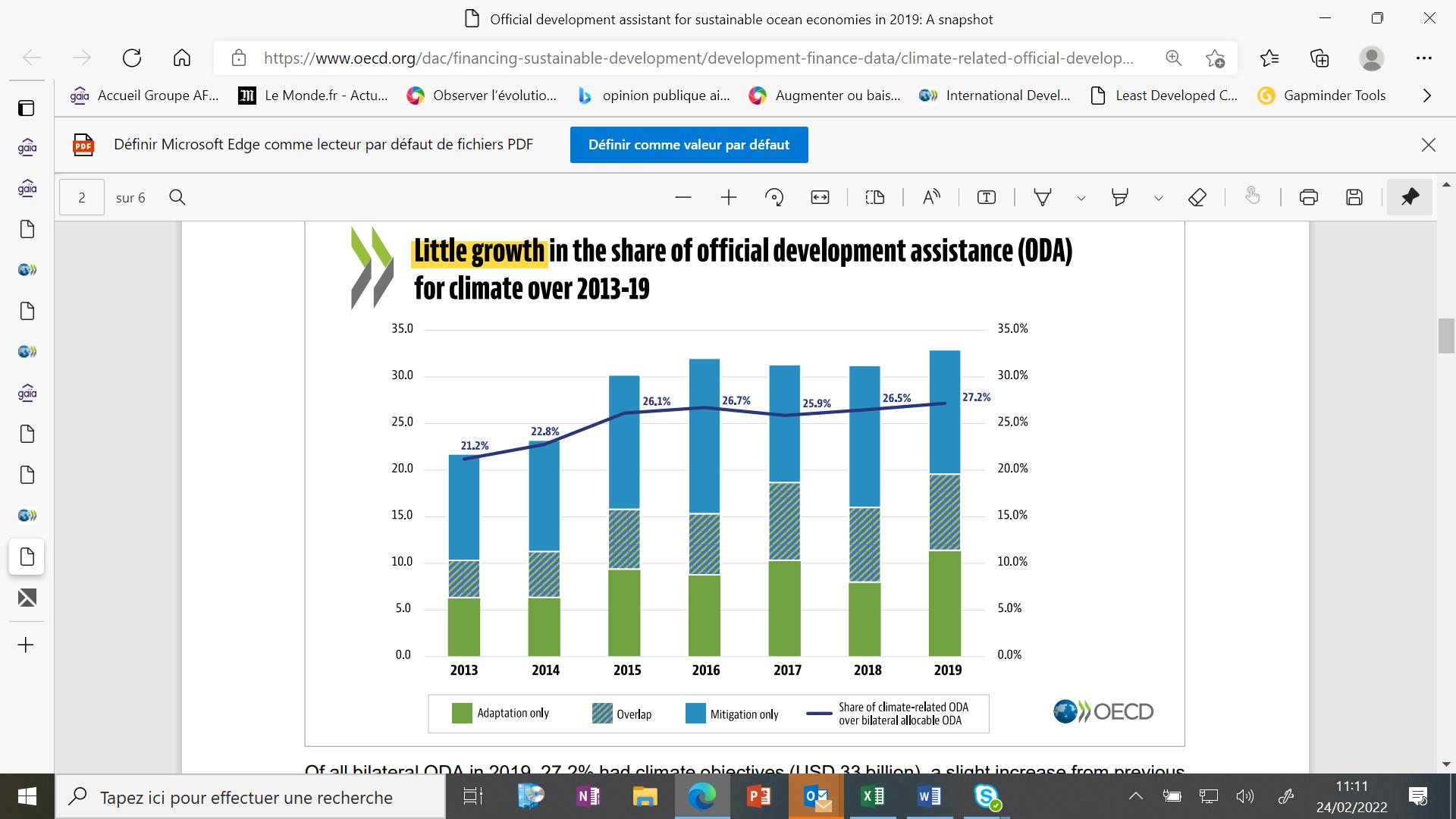
In Copenhagen in 2009, the countries of the North made a commitment to allocate 100 billion in climate finance for developing countries. The controversies surrounding the scope and measurement of this commitment, and in particular its additionality (see box 4), are typical of the current ambiguity between climate finance and ODA. Currently it is estimated that about a quarter of ODA is also eligible and reported as climate finance (Dwyer et al. 2020).21
Box 4 – Additionality of climate finance and development assistance: several possible definitions (according to UNCTAD 2015)
There are four possible definitions of the additionality criterion between ODA and climate finance:
1. Funding above the ODA target of 0.7% of donor country GNI dedicated to climate goals is considered additional.
2. Any climate funding above a baseline (e.g. base year value) that meets the eligibility criteria can be considered additional.
3. Climate finance can also be reported as ODA, but in a capped proportion; for example, no more than 10% of ODA can be reported as climate funding.
4. Climate finance and ODA are completely unconnected; what is declared in one category cannot be declared in the other.
21 However, these common flows are reported at different values in grant equivalent for ODA and in gross transfers (or even commitments) for climate finance.




